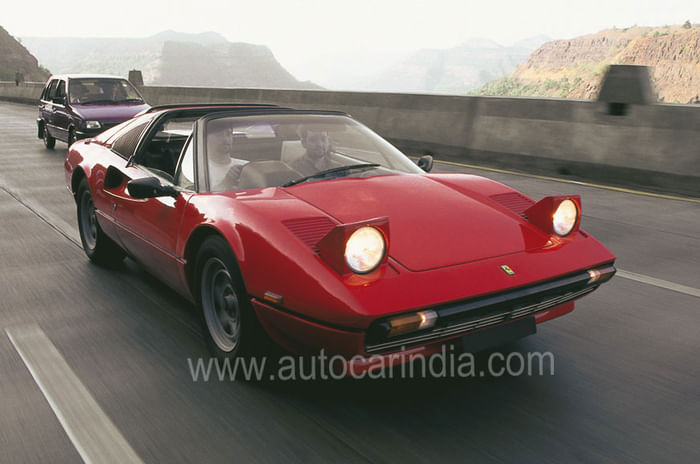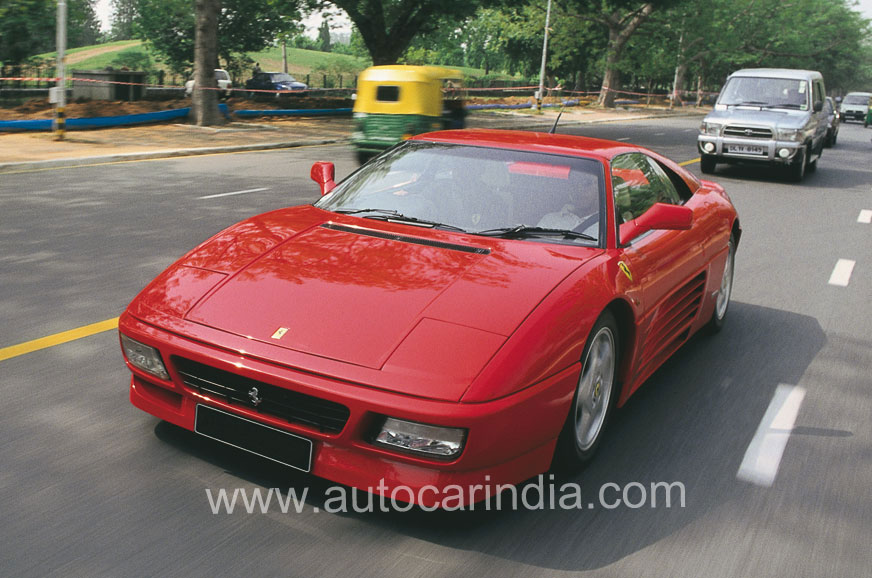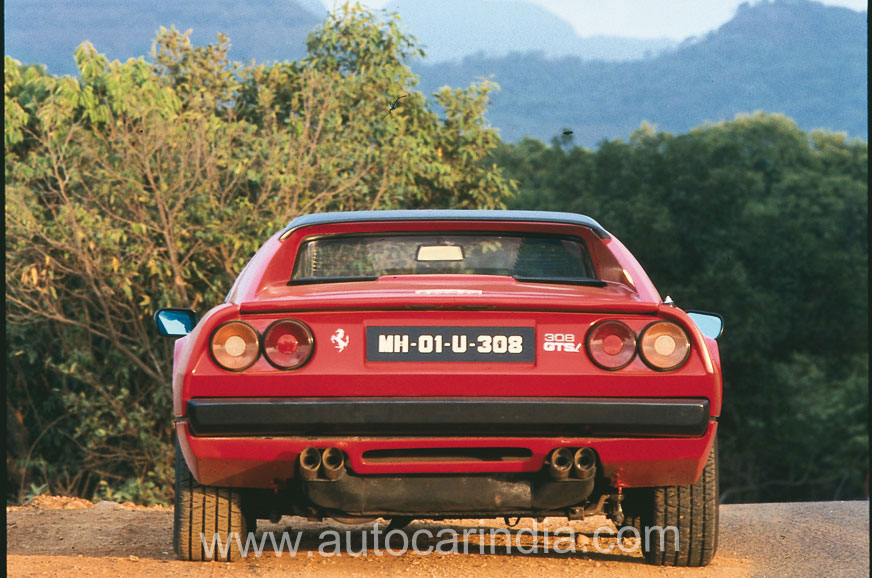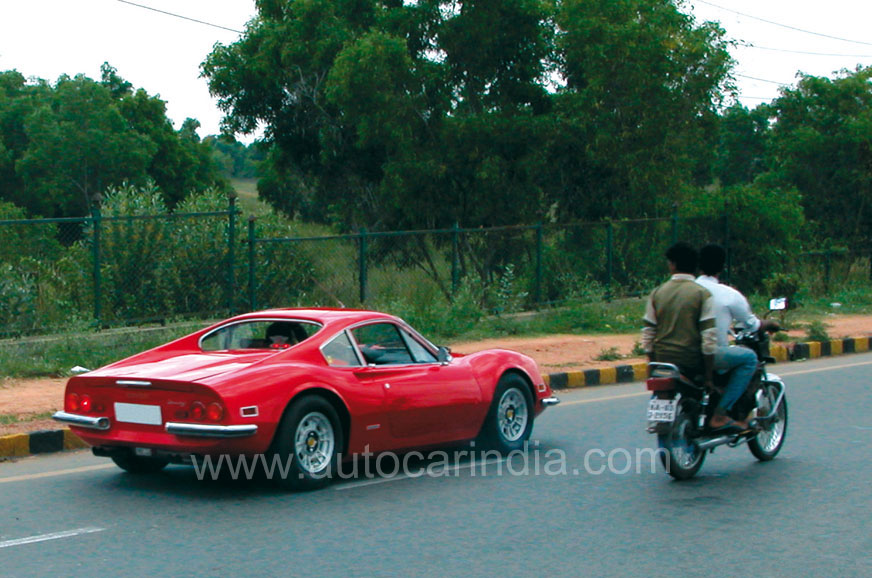God’s green earth isn’t exactly scattered with Ferraris. Highly exclusive, extra-ordinarily com-plex machines even by lofty first world standards, their limited production and stratospheric costs make every single Ferrari sold extra special.
Think about driving and/or owning a Ferrari in India and the complexities multiply rapidly. For starters, there’s the Indian customs and the formidable homologation regulations.
Apply logic to your passion and things get even worse. India’s pathetic pothole and crater-infested roads are exactly what low-slung sports cars don’t need, to say nothing of the choking traffic.
Feed your Ferrari our low octane swill and it will retch and buck as violently as a vintage wine-consuming member of the aristocracy gulping country brew. And what happens if something goes wrong? You pray, import a mechanic, or try and find the only qualified Ferrari technician in India. Easy — that’s one is a billion! So it’s no surprise then that the members of Club Ferrari India can be counted on your fingers, almost.

While little is known about the import of the red cars from Maranello during the early years, vintage and classic car expert Manvendra Singh tells us that the first documented Ferraris in India belonged to a very high ranking Italian diplomat stationed in Delhi. Obviously an enthusiast as well as extremely wealthy, Dr Ross imported a number of sports car exotica, Ferraris and Alfa Romeos included.
The first of the Ferraris was the extremely alluring Ferrari 365 GTC, among the first true 2+2 Ferraris designed for the sporting gentleman. Not to be confused with the famous wedge-shaped Daytona or a couple of others also designated 365, the big coupe actually shared much of the famous supercar’s running gear. A genuine 150mph (240kph) rocket sled, the large displacement 12-cylinder engine pumped out an amazing 320hp.
In comparison, most cars sold in India at the time struggled to make 35! With power steering and self-levelling rear dampers, the GTC was the equivalent of a four-seater McLaren F1 today. And Dr Ross really drove the car too — from Delhi to Khandwa in Madhya Pradesh for a bison hunt no less!
Singh remembers being stunned seeing the smashing-looking Ferrari outside its natural urban habitat. “We followed it in my Fiat like enthusiastic children following the pied piper. And while Dr Ross was nice enough to show us the car and quite amazed that someone actually recognised it, he eventually had to shoo us away as we continued to gawk at it for hours”.
Dr Ross also gifted another of his Ferraris, the wedge-shaped 365 GTB/4 (better known as the 400i) to its caretaker, workshop owner J K Sharma. The magnanimous Dr Ross had earlier also sent Sharma to Maranello in Italy for training.
Another better known ‘Dr Ross Ferrari’ was the spectacular shark-nosed 275GTB that was later bought by another Italian in Mumbai, the late Dr Cesare Rossi, in a single-car auction through the State Trading Corporation (STC).
I have vivid memories of this blood-red beauty speeding past as Dr Rossi would often embark on Sunday drives in Mumbai, the scream from the quad exhaust pipes of the 3.3-litre V12 often bringing pedestrians and traffic to a standstill as the rasping exhaust note reverberated amid the buildings.
Remember, the 275GTB won the GT class at the famous 24 Hours Le Mans race in 1966. Dr Rossi also entered the 275GTB in a couple of classic car events where the red Ferrari was easily the centrepiece.
This car is, unfortunately, no longer in the country.
As can be expected, most Ferrari owners in India are cagey about their prancing horses. Most will happily talk about the car, sing its praises, and revel you with numerous incidents, but flatly refuse to be identified as owners. “People think every Ferrari is worth a crore of rupees, and that’s not exactly healthy,” said one Ferrari-sti.
Of the six Ferraris in Mumbai the most famous must certainly be the F355 F1 that belongs to a young captain of the entertainment industry. Regularly seen screaming around the streets of Mumbai on Saturday nights, this is one enthusiastic driver who’s unafraid to make full use of the Ferrari’s almost 400hp. The after-market exhaust sends out a mind-numbing wail that’s pure F1 car.
See the scarlet beauty get away from the lights close up and you’ll never forget the sight, or blare from the pipes. I haven’t. The other Ferrari often seen is the 348 belonging to the son of a textile magnate.
Of the remaining three in Mumbai — a Mondial and a couple of 308GTs — only one is driveable and in a decent condition. Belonging to an avid car enthusiast and vintage and classic car collector, this 308 is in fine fettle and is also driven hard on a regular basis. The car is carefully housed in a garage on a hillstation situated bang on the Mumbai-Pune Expressway and is often taken for long drives, usually to nowhere and back. Perfect.
The south has its share of Ferraris too. R Gopinath, a big enthusiast from Coimbatore, has a Ferrari 308GTS. His ’79 model had 100,000km on when he imported it and he’s put on an additional 8000-9500km on the clock.
"I was expecting the car to give a lot of trouble but surprisingly it hasn't," he says. Apart from the tyres, clutch and some suspension parts, there have been no problems. No oil leaks, no belt changes, no major suspension repair, nothing. And the comparatively lower compression ratio of 8.8:1 allows Gopi to run our regular low octane petrol. As with all the cars here, tip-toeing over speedbreakers and potholes is vital. Gopi agrees that there is something special about his Ferrari. "This is the first car I've owned which is not a car. It has a special character, which almost makes it human."
Like a Bangalore tycoon who owns a couple of Ferraris — a superb 246 GT Dino and another F355 — Kolkata too has its Ferrari-man: a tea estate owner who drives yet another F355. Things are looking up. Ah, there’s that young willow-wielding bloke who’s about to get a spanking new 360 Modena. Best thing you never bought, Sachin.
Some of the most delicious Maranello metal screaming around belongs to . . . you guessed it . . . another Mr Anon. This ‘rather-be anonymous’ business tycoon from South India owns a fleet of supercars from every continent. To get you his cars’ pictures we had to blank out the plates, conceal the owner’s identity and location and only then did he invite us for a ride.
Unlike many poorly maintained supercars which suffer in India for want of spares and proper service, this collection is kept at the other extreme. Each car is hermetically sealed and stored in giant plastic covers that are tightly zipped to keep out dirt and dust. Humidity- controlled air is pumped in from one end to keep the leather and rubber parts in top shape. Taking pride of place is an immaculately kept 246 Dino which looks absolutely stunning in the metal, the harsh Indian sun glinting in every curve as it pulled out of the garage.
You appreciate the compactness of this ‘baby’ Ferrari as it burbles onto crowded streets teeming with cyclists and autorickshaws. Floor the throttle and that umistakeable scream from this legendary V6 has everyone within a 100-metre radius first looking, staring and then gaping at you. What you see from the inside apart from those wide-eyed faces is the classic and functional Ferrari interiors wrapped up in black pleated leather that still smells fresh. The view over those sensuous front fenders that rise above the bonnet line and then drop away is like running your eyes over the torso of J Lo. This car is all about feel and character and not horsepower. It does something to your senses that’s hard to explain and the fact that it works so well in India, riding gamely over pockmarked roads, makes it even more desirable.
Possibly the most desirable Ferrari on the sub-continent is an immaculate F355 Spyder belonging to the same collector. The fly-in-the-ointment is the unpalatable blue colour but come within 10 feet of it and you’re hooked solid.
Stunning looks, brilliant handling mated to a brilliant 3.5-litre, 375hp five valves per cylinder V8 engine that wails to 8250rpm makes the F355 one of the all-time greats of the prancing horse stable.
The F355 with its F1-style paddle gearshift is also one of the easiest Ferraris to drive and immensely practical. This one is the owner’s favourite who drives it hard and mainly at night. And the fact that he has to buy drums of 100 octane fuel at Rs 65 per litre doesn’t seem to bother him much. Oh, to be rich!
Like Alice in Wonderland or an F1 car screaming down a high street past everyday traffic, a Ferrari on one of our roads is simply unbelievable. Snatch a glimpse of one in the flesh and you’ll do a double-take.
Yes, yes, we’ve seen numerous Ferraris in the flesh, driven a couple too, but driving a Ferrari here on Indian roads, howling past autorickshaws, pedestrians and cows is nothing short of surreal. It’s like being between two worlds — the real and an imaginary one.
As you can well imagine, members of the Ferrari club are fiercely protective about their thoroughbreds. Start pawing one of their lovelies and you’re ‘Tyson’ the Rottweiler’s lunch. So when Kenny Bahia offered to let me have a go in his 348 GTS in Delhi, I thought I had heard wrong. “You mean I can drive it?” I sputtered over the phone line.
Although I’d had a longish drive in a Ferrari 308 in Mumbai a couple of years ago, the car was very second-handish. Not Kenny’s. Parked in a perfectly manicured garage that looked like a shrine to Ferrari, with huge Scuderia shields on the walls and the car draped in a red, light, silky monogrammed cover, the 348 looked almost new. Unveiling the car immediately imparted that surreal feel. You just don’t expect a perfectly maintained, screaming red Ferrari with splashes of chrome to come rolling out of a gate in Vasant Vihar.
Though Kenny drove the 348 at first and we stopped for some pictures, it was soon my turn to take the wheel.
Of course I had the butterflies, an intoxicating cocktail of excitement and fear. And, the moment I strapped myself into the driver’s seat, I realised I’d got the wrong shoes on. Blame the parents, my size 11-and-a-half flippers and walking shoes meant it was a tight fit. What I needed for the dainty and confined pedals were squash shoes, but I’d simply have to manage.
Just firing up the raucous 3.4-litre longitudinal V8 feels great. Super-responsive to even a mere dab of the accelerator, this Latin tenor sings and whoops on command, the valvetrain adding mechanical hardness to the trumpeting exhaust. It makes loud exhausts on more mundane machinery sound like nothing more than a case of rather severe flatulence. Remember Ferrari went from a transverse V8 engine, like on the 308/328 to a longitudinal one on the 348. The gearbox as a result is placed at a right angle to the engine, similar to earlier Formula 1 cars like the flat-engined 312 T (for ‘transversale’) of the ’70s.
Drive the 348 once and you’ll never forget the experience. Sending almost 300hp through right angles is no easy task, and the result on the 348 is painful gear selection. The slow-witted long-throw gearbox needs a firm confident shove, not the ginger ‘here sir’ I was attempting, and the 348 laughed. It unceremoniously jumped out of gear the first couple of times, the long clutch making matters even worse. ‘Saint’ Kenny smiled.
Delhi’s morning traffic with the roundabouts, rickshaws and manic Ambassadors was not the ideal playground for a 300hp sports car with an attitude problem. Countless furrowed brows and ego plummeting ‘you first’ pats on the brakes meant the Ferrari felt as confined as a racehorse in a supermarket.
At these speeds, in start-stop traffic, the Ferrari magic was all but invisible. The steering was slow-witted and heavy and the brakes wooden, with every one of the controls needing deliberate and conscious input.
A bit like the first time I’d driven the Mahindra Marshal! But rather than merely prancing around, what this snorting colt needed was space. Space to lengthen its stride, stretch its legs, to run free.
The open roads, when they finally arrived, changed the character of the 348 completely. By now I was also more familiar with the gearbox, clutch and brakes and as a result the Ferrari suddenly started to make sense, awakening from hibernation, transforming into a real supercar. All ‘this-surely-can’t-be-it’ questions were wiped out in an instant as the 348, imago-like, literally felt it had sprouted wings.
Give the 348 its head and you realise why entire forests have been denuded in praise of the Italian marque, why normally sane human beings permanently tattoo prancing horses on strange parts of their body. Above 4000rpm and the Ferrari unleashes serious venom, the 348 jumping to another warp entirely.
Now think F1 in-car camera. The red nose, the blurring verge flashing by, and the symphony behind your head. Five seconds to a hundred among breaks in Delhi morning traffic, real heady stuff. The steering too came magically alive, balancing up superbly on the few actual corners I managed to drive. Suddenly the 348 had lived up to all the Ferrari hype, all the expectation, and more.
I wanted to head for the hills, disappear onto some meandering country roads, let the 348 play but it was not to be. Work schedules, responsibilities, Kenny’s not mine, meant dream time had to come to an end. That was it, I thought, but “come again,” he said, “we can go for a longer drive”. Truly a saint.
KEEP THEM PRANCING
Maintaining a Ferrari in India is a Herculean task. Parts just have to be imported at an exorbitant cost, but the Internet has made things much easier. Just type ‘Ferrari 308 parts’ for example in a search engine such as Google and you get links to numerous vendors of parts with varying prices, as well as some ‘Do It Yourself’ literature.
However prices, as expected, are far from friendly. Try $125 for a 308 gasket, or $75 for each of the valves, sometimes 40 to an engine. Finding someone qualified to work on the cars is another huge problem. A full workshop manual in English is essential and even then, as can be expected, it’s trial and error. And errors cost both time and money. Sadly a number of cars are never nursed back to health.
Amazingly, there is one qualified Ferrari technician in the country, who is trained at handling the more modern Ferraris. Kersi has trained at Maranello and is equipped with specialised tools (like the SD1 computerised datalogger) that are usually given only to dealers. Kersi insists on frequent fuel filter changes as well as regular cambelt replacements. And while regular service may sound simple, don’t forget you need to pull the F355’s engine out to execute a textboox cambelt change! Of course, nothing less than 95 Octane with a decent peg of octane booster will do.
*This article first appeared in Autocar India's December 2002 issue.
Also see:



